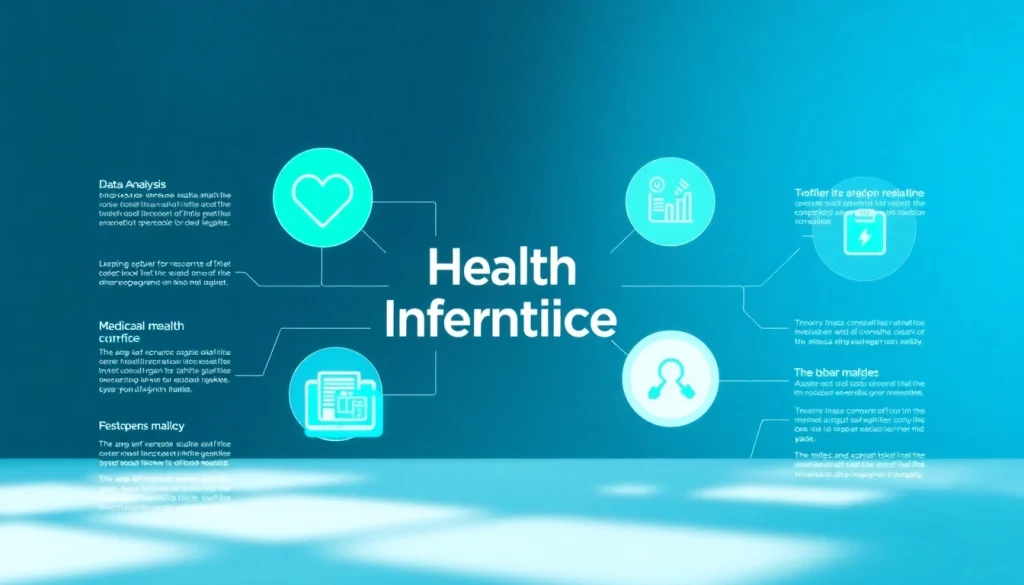Understanding Health Informatics
Health informatics is a rapidly growing field that aims to improve healthcare delivery through the effective use of data and technology. At its core, health informatics combines expertise from healthcare, information science, and computer science to optimize the management of health data, ultimately enhancing patient care and clinical workflows. By leveraging data analytics, electronic health records (EHRs), and patient management systems, health informatics plays a crucial role in creating a more efficient healthcare environment. For more insights and resources, explore www.informaticsview.com.
What is Health Informatics?
Health informatics refers to the interdisciplinary study of how information is organized, analyzed, and applied within the healthcare sector. It encompasses a variety of sub-fields, including digital health, electronic records, data analysis, and artificial intelligence applications. The goal is to enhance patient care, reduce errors, streamline processes, and facilitate better communication among healthcare providers. By systematically managing health information, informatics professionals can ensure that practitioners have access to the most accurate and relevant data, leading to improved decision-making.
The Role of Technology in Healthcare
Technological advancements have revolutionized the healthcare landscape. Innovations such as telemedicine, mobile health apps, and wearable technology have transformed how patients engage with healthcare services. Through remote monitoring, patients can now manage chronic conditions from home, reducing hospital visits and encouraging proactive health management. Furthermore, technologies like artificial intelligence and machine learning are helping in predictive analytics, enabling healthcare providers to identify potential health issues before they become critical. This technological shift enhances patient experience and drives efficiencies within healthcare organizations.
Key Terminology in Health Informatics
Understanding specific terminology is essential for grasping the intricacies of health informatics. Here are some key terms:
- Electronic Health Records (EHRs): Digital versions of patients’ paper charts, providing real-time access to patient records.
- Health Information Exchange (HIE): A system that allows healthcare organizations to share patient information electronically, improving collaboration and continuity of care.
- Clinical Decision Support Systems (CDSS): Computerized systems that analyze data from various sources to assist healthcare providers in making informed clinical decisions.
- Telehealth: The delivery of health-related services through telecommunications technologies, enabling remote patient consultations and monitoring.
Core Components of Health Informatics
Data Management Systems
At the heart of health informatics are data management systems. These systems are designed to store, organize, and manage health data, facilitating easy access for healthcare providers. Effective data management is critical for ensuring that information is accurate, timely, and secure.
Data management systems encompass various databases that store patient information, treatment histories, and clinical outcomes. By employing standardized formats and protocols, these systems allow healthcare professionals to share and analyze data across different platforms. This interconnectedness is vital for improving care coordination and reducing errors associated with miscommunication.
Clinical Decision Support Systems
Clinical decision support systems (CDSS) are integral to enhancing decision-making capabilities in healthcare settings. By analyzing patient data and clinical guidelines, CDSS can provide healthcare professionals with actionable insights. For example, these systems can alert clinicians about potential drug interactions, suggest diagnosis based on symptoms, and personalize treatment plans based on patient histories.
Implementing a robust CDSS can lead to improved patient outcomes by promoting best practices and reducing variability in care. Furthermore, CDSS can empower healthcare providers to make data-driven decisions, ultimately leading to enhanced safety and quality of care.
Telehealth Innovations
Telehealth has emerged as a critical component of modern healthcare, particularly following the COVID-19 pandemic. By allowing patients to connect with healthcare providers remotely, telehealth services have transformed access to care. These innovations not only improve healthcare accessibility for patients in rural areas but also reduce the burden on healthcare facilities.
The integration of video conferencing, mobile apps, and remote monitoring tools into healthcare delivery enables patients to receive consultations, follow-ups, and rehabilitation sessions without the need for physical visits. Telehealth’s flexibility supports enhanced patient engagement, enabling individuals to manage their health proactively.
Challenges in Health Informatics Implementation
Data Privacy and Security Concerns
As health data becomes increasingly digitized, ensuring data privacy and security is paramount. Healthcare organizations face challenges in protecting sensitive patient information from breaches and cyberattacks. Compliance with regulations such as the Health Insurance Portability and Accountability Act (HIPAA) is essential, as it establishes national standards for safeguarding medical records.
Organizations must implement robust security measures, including encryption, access controls, and regular security assessments, to protect against unauthorized access. Additionally, training staff on data privacy policies and best practices is crucial to maintaining a secure environment for sensitive health information.
Integration of Systems in Healthcare Settings
Integration of various health informatics solutions can pose significant challenges for healthcare organizations. Often, disparate systems may not communicate effectively with each other, leading to data silos and inefficiencies. Successful integration requires careful planning, a comprehensive understanding of organizational needs, and the use of interoperability standards.
Organizations should assess existing systems and adopt solutions that support data sharing and compatibility. Collaborative efforts among stakeholders, including IT professionals and healthcare providers, are crucial for designing an integrated informatics ecosystem that enhances care delivery.
Training Healthcare Professionals
Implementing health informatics solutions is not sufficient without ensuring that healthcare professionals are adequately trained to use these tools. Technology adoption can be hindered if staff are unfamiliar with new systems, leading to resistance and decreased effectiveness.
Healthcare organizations should invest in comprehensive training programs that help employees understand the functionalities of informatics systems, including data entry, navigation, and interpretation of analytics. Continuous education and support are vital for fostering a culture of proficiency and confidence in using health informatics technologies.
Best Practices for Effective Health Informatics
Choosing the Right Technology Solutions
Selecting the appropriate technology solutions for a healthcare organization requires thorough evaluation and alignment with organizational goals. Decision-makers should assess the specific needs of healthcare providers, patient populations, and operational workflows. Collaborating with stakeholders is essential to identify the most effective solutions that can be integrated into existing systems.
Features such as user-friendly interfaces, scalability, data analytics capabilities, and support services should be carefully considered. By prioritizing the right technology, organizations can enhance patient care and streamline clinical processes.
Enhancing User Experience
User experience (UX) plays a critical role in the acceptance and utilization of health informatics systems. Healthcare professionals are more likely to engage with systems that are intuitive, efficient, and designed with their workflows in mind. Organizations should prioritize the development of user-centered solutions that minimize complexity and facilitate ease of use.
User testing and feedback should be integral to the design process, allowing for iterative improvements based on real-world applications. Enhancing UX not only boosts system adoption but also contributes to increased productivity and satisfaction among healthcare providers.
Regularly Updating Systems and Protocols
The healthcare landscape is constantly evolving, with new regulations, technologies, and clinical practices emerging regularly. Therefore, it is essential for healthcare organizations to commit to regular updates and maintenance of their informatics systems.
This includes not only software updates but also ensuring that protocols and guidelines reflect the latest evidence-based practices. Establishing a governance structure for ongoing evaluation and improvement can help organizations adapt quickly to changes and continue to provide high-quality patient care.
The Future of Health Informatics at www.informaticsview.com
Emerging Trends in Healthcare Technology
The future of health informatics is characterized by rapid advancements and emerging trends that promise to reshape healthcare delivery. Among these trends is the increasing role of artificial intelligence (AI) in predictive analytics, helping clinicians identify patients at risk for complications and enabling personalized care plans.
Another trend is the shift toward patient-centered care, where patients increasingly participate in their healthcare decisions through access to their health data and engagement tools. Mobile health applications and wearable devices are empowering patients to take control of their health, promoting preventive care and adherence to treatment plans.
The Impact of AI and Big Data
AI and big data have the potential to revolutionize health informatics by providing unprecedented insights into patient populations and clinical trends. Machine learning algorithms can analyze vast amounts of data to identify correlations and trends that may go unnoticed by human analysts. Furthermore, AI can enhance diagnostic accuracy by supporting clinicians in interpreting complex medical images and providing clinical decision support.
Organizations must invest in robust data infrastructure and analytics capabilities to harness the full potential of AI and big data in their informatics strategies. This data-driven approach can lead to improved outcomes, reduced costs, and enhanced patient satisfaction.
Enhancing Patient Care Through Informatics
Ultimately, the overarching goal of health informatics is to enhance patient care. By effectively managing and utilizing health data, healthcare organizations can provide more accurate diagnoses, streamlined treatment plans, and improved patient engagement. The adoption of health informatics solutions leads to better communication among stakeholders, contributing to a holistic approach to patient care.
As the healthcare landscape continues to evolve, organizations that prioritize health informatics will be better positioned to meet the challenges of the future and deliver high-quality care that improves patient outcomes and supports population health.





